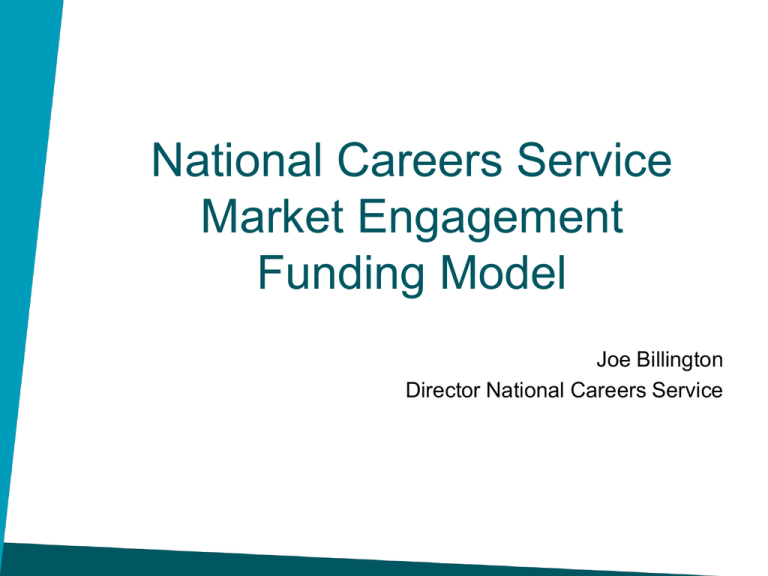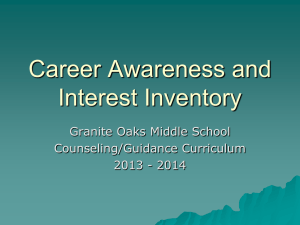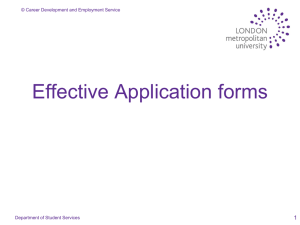- WhatDoTheyKnow
advertisement

National Careers Service Market Engagement Funding Model Joe Billington Director National Careers Service Objectives of Funding Model Workshop The National Careers Service is developing a funding model which focuses on supporting customers to achieve outcomes in line with their career and work aspirations. The objectives of this workshop are: • To seek views on the strengths, opportunities and weaknesses of the proposed approach • To gain understanding of what needs to be considered in the implementation and transition to an outcomes predicated funding model. Strategic Context • Right Advice Right Time • Autumn Statement • Heseltine • Skills Investment Statement National Careers Service • Delivers 90,000 face-to-face sessions per month • Has a specific focus on supporting those looking for work • Comprehensive coverage demographically, geographically and for sectors • Highly regarded labour market information • Over 2,500 professional careers advisers • Connected to the wider skills sector • Close links with other parts of government Benefits • Outcomes • Usage • Awareness • Quality Area Based Service • Local service to comprise face-to-face, telephone and web services. • Each area provider will be required to provide services for all specialist groups • Proactive facilitative role to connect and inspire people to identify and exploit careers opportunities • Local information pages of the National Careers Service website National Call Centre • General query management, signposting and triage – Immediate national information and advice – Referring to local or specialised advisers – Answering general queries – Support for web users • Proactive telephone careers advice for – Area and national campaigns – National partnership activity – Central contact point for partners • Complaint handling What the funding models pays for This includes: • Delivery of the National Careers Service • Development, collection and dissemination of local labour market information • Co-location in a variety of premises including Jobcentre offices and further education colleges • Continuous quality improvement • Local marketing of the service • Training and development • Web site management • Local leadership Principles of Funding Model For area based delivery • Funding will be for three kinds of outcomes o o o • • • • • • Customer satisfaction Career management Jobs and learning Price paid to contractors will vary by customer type but not in the way the service is received Maximum amount that is earned on each type of outcome and each type of customer A ‘digital by default’ approach Resources focused on providing services to priority groups. No separate budget identified for non delivery (marketing, training, administration etc) The balance of funding and unit cost for each outcome may vary from year to year. Principles of Funding Model For the national contact centre: • Funding will be earned on actual calls received and made • A proportion of the funding will be earned on customers satisfaction outcomes • The national contact centre will deal mostly with information enquiries , triage and signposting and the payment per call will reflect this • Proactive calling will be contracted for • Pay for calls that successfully result in customers engaging with the National Careers area based service. Customer Satisfaction outcomes • Earned when a customer has a customer has a careers intervention comprising of relevant information and advice • Funding of this outcome is intended to incentivise high quality careers interventions • Payment higher for customers in priority groups • No limitation on the mode of delivery or the number of interventions • Funding earned when the customer is satisfied that they have relevant advice and a clear action plan Career Management Outcomes Earned when a customer engages in career management over time and demonstrates that the career intervention has made a difference including; • Demonstrates progression through an action plan • Evidenced though the lifelong learning account • Paid at a higher level than customer satisfaction outcomes and higher for customers in priority groups. • Could include evidence such as a customer accessing their lifelong learning account after the initial intervention or have loaded their CV to the lifelong learning account. Jobs and Learning outcomes Jobs and learning outcomes will be earned when a customer enters learning or work or make significant progress. • Jobs and learning outcome payments will be higher for customers within priority groups • A single jobs and learning payment will be paid • Outcome payment will be on the based on evidence from independent research that a proportion of customers have achieved jobs and learning outcomes. Funding Model Illustrations National proportions Clients Priority Non-Priority Customer Satisfaction 400,000 100,000 Jobs & Learning 250,000 250,000 Career Management 150,000 75,000 Budget £ 68,000,000 Questions • What are the possible unintended consequences and inappropriate behaviours and how can they be mitigated? • How will the proposed outcomes and the impact on customers be demonstrated? What are the right evidence requirements to support these outcomes? • Will a payment differential between priority and non priority groups focus resources while retaining a universal service? • How can we ensure that this model ensures continuous quality improvement, training and professional development, collection and display of LMI and other essential aspects of high quality delivery? • How can the proposed funding model be used to incentivise local leadership and encourage service providers to engage proactively in local communities? • How can we ensure a successful implementation of a model like this (including the cost and affordability of the proposals)? Thank you and any questions facebook.com/nationalcareers @nationalcareers Comments: xxxxxxx@xxxxxxxxxxx.xxx











